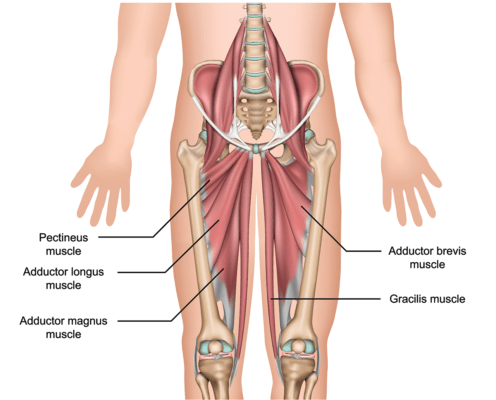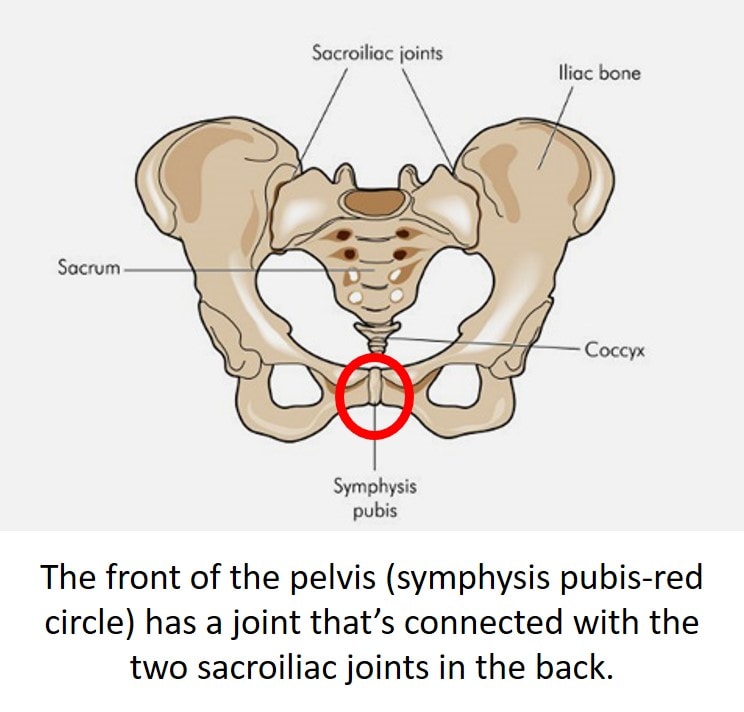Sports Hernia Surgery?
I’ve seen numerous patients throughout the years who have undergone sports hernia surgery (aka surgery for “athletic pubalgia”) and it’s failed. Hence, let’s explore what this diagnosis is, what’s likely causing it, and what this surgery entails. Let’s dig in.
What is Sports Hernia (Athletic Pubalgia)?
A sports hernia (aka athletic pubalgia) is pain in the lower abdominal area and groin, but without the presence of a true hernia. An abdominal hernia usually means that there is a break in the abdominal wall which allows part of the intestines to push out. However, here, no such hernia exists, despite the name given to the condition being “sports hernia”.
Athletes often report one-sided pain in the lowest part of the abdomen (just above the groin area) as well as groin pain made worse with activity. Most athletes will say that the pain recurs when performing a specific activity (2). The structures involved include the abdominal muscles that attach to the front of the pelvis bone (symphysis pubis) and the adductors that attach the thigh to this area. In the diagram here, I have highlighted those areas in yellow.

Medicalstocks/Shutterstock
What Causes a Sports Hernia?
Regrettably, nobody is 100% certain, but a few things have been associated with the diagnosis:
- Hip impingement (FAI) (4)
- Adductor or iliopsoas tendinopathy
- Osteitis Pubis (5)
- SI joint (pelvic ring) instability
There is a relationship between athletic pubalgia and hip FAI (hip impingement). However, be very cautious here as in our experience, getting hip labrum surgery to treat your athletic pubalgia is rarely a good idea. Why? The procedure is not as effective as many surgeons believe.
Many patients with this problem have abnormal and degenerated/partially torn adductor or iliopsoas tendons. Remember from above (areas in yellow highlight) that these are the tendons that attach into this area. These patients are often tender in these spots.
Osteitis pubis means that the joint in front of the pelvis (symphysis pubis) is getting arthritic from too much wear and tear. In this case, that joint, located in the middle and just above your genitals, is very tender to the touch. Patients with issues here often report pain with sexual activity. Why this happens is discussed below.

Blamb/Shutterstock
A big cause of athletic pubalgia that often goes undiagnosed and unrecognized in orthopedic clinics is pelvic ring instability. The pelvis is a ring with two sacroliliac (SI) joints in the back and a symphysis pubis joint in the front (image shown here). Hence, if the SI joint in the back moves too much, the symphysis pubis will as well, leading to pain at the front of the groin. Since the lower abdominal and adductor muscles attach there, they also get yanked on and become painful. If this goes on long enough, the symphysis pubis joint can become arthritic (osteitis pubis) and/or the tendons that attach here and acquire small tears.
How Do You Treat a Sports Hernia?
Physical therapy is obviously the first option. However, not all physical therapists may have a good idea of how to treat this problem. One group that I have no affiliation with but has helped many of my athletic pubalgia patients is IPA. They have a strict training program with very high requirements. Hence, don’t just get any PT on your insurance network, but a therapist specially trained to understand what’s wrong. Core exercises should be part of the plan as well as manual therapy (mobilization of the SI joints).
What is Sports Hernia Surgery?
Many surgeons approach this problem like an abdominal hernia, even though there is no abdominal hernia. This is usually an endoscopic repair, oftentimes with synthetic mesh installed to “strengthen” the abdominal wall. Why is surgery needed to “fix” a hernia that isn’t really there? That’s an important question.
What is there? A weakening of the abdominal wall and an unstable symphysis pubis joint. Will a hernia repair fix that? Not really.
In addition, sometimes the surgeon cuts the inguinal nerve in an attempt to relieve pain. The idea is that the scarring from sports trauma has caused the nerve to become entrapped. This is called an inguinal neurectomy.
Another common procedure performed is an adductor longus tenotomy. This often takes the form of a surgeon exposing the adductor tendon and then scoring it with a scalpel in order to promote healing. Other times, a percutaneous tenotomy is performed, which is basically using an instrument inserted through the skin to “rough up” the tendon and promote healing.
Finally, some surgeons will combine all of this with a hip labrum surgery, not because the hip hurts, but because there is a belief that certain hip MRI measurements are abnormal. However, be very cautious here as many of these hip labrum MRI measurements are often abnormal in normal patients without hip problems. Meaning that measurements alone are not enough at this point to pull the trigger on hip labrum surgery.
Does Sports Hernia Surgery Work?
How well does all of this work? First, realize that most of the studies into success rates are with small case series and very little high-level research exists. Also realize that none of these surgeries have been compared against sham surgery, which is a significant problem. Why? They require extensive downtime which in and of itself, without any surgery, may heal the problem.
Having said that, in one study of athletic pubalgia surgery success rates, only 25% of patients were able to return to their previous level of sports (5). When FAI surgery was added into the treatment, this seemed to improve outcomes. However, I would caution you to read this blog on the problems with FAI surgery before you consider that procedure. Other low-level studies report good rates of success, but oftentimes they use a mix of different surgeries.
Is There a Better Way to Treat Athletic Pubalgia without Surgery?
Remember above when I reviewed that an often missed diagnosis in orthopedic clinics is SI joint and pelvic ring instability? This problem is a huge cause of sports hernia diagnoses. The treatment that works that we’ve used for many years is injection-based therapy using both x-ray and ultrasound guidance. Meaning, no surgery is involved, so there are fewer side effects and a much quicker recovery.
In this procedure, the entire pelvic ring is treated with the goal of tightening down loose ligaments and prompting healing in damaged tendons. For ligament tightening, this includes the SI joints and ligaments in the back of the hip as well as the symphysis pubis in the front. These injections are performed under a combination of fluoroscopy (real-time x-ray) and ultrasound guidance to ensure that the injection gets to the right spots. The beat-up abdominal and adductor tendons are also injected using ultrasound guidance to promote healing.
What is injected? If the problem is less severe, then using the patient’s own concentrated blood platelets that contain healing growth factors is often enough (high dose platelet-rich plasma or PRP). If the issues are more severe, then the patient’s own stem cell containing bone marrow concentrate is used.
The upshot? Sports hernia surgery is invasive and as I have reviewed, oftentimes doesn’t address the underlying problem, which is usually pelvic ring instability. Hence, using big surgeries to heal the problem is often overkill which exposes the patient to unnecessary risks.
__________________________________________
(1) Meyers C, Foley D, Garrett W, Lohnes J, Mandlebaum B. Management of severe lower abdominal or inguinal pain in high-performance athletes. PAIN (Performing Athletes with Abdominal or Inguinal Neuromuscular Pain Study Group). Am J Sports Med. 2000 Feb;28(1):2–8. https://www.ncbi.nlm.nih.gov/pubmed/10653536
(2) Gilmore J. Groin pain in the soccer athlete: fact, fiction, and treatment. Clin Sports Med. 1998 Oct;17(4):787–793, vii. https://www.ncbi.nlm.nih.gov/pubmed/9922902
(3) Birmingham P, Kelly B, Jacobs R, McGrady L, Wang M. The effect of dynamic femoroacetabular impingement on pubic symphysis motion: a cadaveric study. Am J Sports Med. 2012 May;40(5):1113–8. https://www.ncbi.nlm.nih.gov/pubmed/22392561
(4) Larson C, Pierce B, Giveans M. Treatment of athletes with symptomatic intra-articular hip pathology and athletic pubalgia/sports hernia: a case series. Arthrosc J Arthrosc Relat Surg Off Publ Arthrosc Assoc N Am Int Arthrosc Assoc. 2011 Jun;27(6):768–75. https://www.ncbi.nlm.nih.gov/pubmed/21624671
(5) Elattar O, Choi HR, Dills VD, Busconi B. Groin Injuries (Athletic Pubalgia) and Return to Play. Sports Health. 2016;8(4):313–323. doi: 10.1177/1941738116653711

If you have questions or comments about this blog post, please email us at [email protected]
NOTE: This blog post provides general information to help the reader better understand regenerative medicine, musculoskeletal health, and related subjects. All content provided in this blog, website, or any linked materials, including text, graphics, images, patient profiles, outcomes, and information, are not intended and should not be considered or used as a substitute for medical advice, diagnosis, or treatment. Please always consult with a professional and certified healthcare provider to discuss if a treatment is right for you.